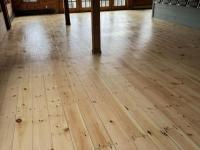The Finches are Coming
 The authors were surprised to hear and see pine grosbeaks (female, shown) on a recent walk -much earlier than expected for these northern finches. Courtesy of Jeff and Allison Wells
The authors were surprised to hear and see pine grosbeaks (female, shown) on a recent walk -much earlier than expected for these northern finches. Courtesy of Jeff and Allison Wells Redpolls (shown) are also arriving early, with one having shown up (and photographed) on Monhegan Island in September. Courtesy of Jeff and Allison Wells
Redpolls (shown) are also arriving early, with one having shown up (and photographed) on Monhegan Island in September. Courtesy of Jeff and Allison Wells Already this year, pine siskins seem to be "everywhere." Courtesy of Jeff Wells
Already this year, pine siskins seem to be "everywhere." Courtesy of Jeff Wells The authors were surprised to hear and see pine grosbeaks (female, shown) on a recent walk -much earlier than expected for these northern finches. Courtesy of Jeff and Allison Wells
The authors were surprised to hear and see pine grosbeaks (female, shown) on a recent walk -much earlier than expected for these northern finches. Courtesy of Jeff and Allison Wells Redpolls (shown) are also arriving early, with one having shown up (and photographed) on Monhegan Island in September. Courtesy of Jeff and Allison Wells
Redpolls (shown) are also arriving early, with one having shown up (and photographed) on Monhegan Island in September. Courtesy of Jeff and Allison Wells Already this year, pine siskins seem to be "everywhere." Courtesy of Jeff Wells
Already this year, pine siskins seem to be "everywhere." Courtesy of Jeff Wells
A few days ago, we were walking the dog when we heard what sounded exactly like the sweet call notes of pine grosbeaks. This surprised us. It seemed too early for these northern finches to be here. But there they were, six of them in the top of a tree in the neighborhood.
A glance at eBird and we knew we weren’t the only ones to have found pine grosbeaks here in Maine in the last week or two. No, they’re not in everyone’s backyard, but a handful have been found across the state.
Birders (ourselves included) in the northeastern U.S. always seem to get particularly excited by the prospect of finding northern finches in winter.
Why is that?
There are a number of reasons. For one, the most northerly breeding of the northern finches don’t show up down this way every year. Some years, they stay year-round up north. That’s different from regular migrants like snow buntings, American tree sparrows, red-necked grebes, red-throated loons, and long-tailed ducks that breed to our north but come spend winters here every year. Redpolls don’t come south every year. And although in Maine we have some breeding pine grosbeaks (very few), evening grosbeaks, pine siskins, and white-winged crossbills, the number that come south from Canada and Alaska in winter shows wild swings with almost none some years and lots in other years.
The swings in winter abundance of some of these northern finches have been shown to follow a general pattern of coming south in bigger numbers every two years. The mysterious cyclic nature of the appearance of larger numbers of northern finches here in the northeastern U.S. is another reason that we birders find them intriguing.
The rise of winter bird feeding, as well as the large numbers of people who make participation in one or more Audubon Christmas Bird Counts a part of their early winter tradition, seems likely to have contributed to the excitement birders have in anticipating whether these northern finches will grace them with their presence.
That’s why the Winter Finch Forecast , now hosted by the Finch Research Network and which we have written about in past columns, garners so much attention when it comes out. It’s like the economic forecasts that investors eagerly await—but, we think, much more fun and interesting!
The 2025/26 forecast has predicted a good flight of winter finches into the northeast this winter. Along with the pine grosbeaks, there have already been a few redpolls here in Maine including an amazingly early one photographed on Monhegan in September. One passed by an observer documenting a large movement of birds passing through Long Island, New York, last week. Evening grosbeaks have been found in greater numbers across Maine already this fall; they’re one of our favorite birds, so we will be especially looking and listening for them. There have been a few as far south as New Jersey and Maryland. White -winged crossbills have been few and far between so far this fall here in Maine, but red crossbills seem to be in many places, especially closer to the coast. As for pine siskins, they seem to be widespread everywhere.
Enjoy the rest of the finchy fall and what may be a finchy winter as well.
Jeffrey V. Wells, Ph.D., is a Fellow of the Cornell Lab of Ornithology and Vice President of Boreal Conservation for National Audubon. Dr. Wells is one of the nation's leading bird experts and conservation biologists. He is a coauthor of the seminal “Birds of Maine” book and author of the “Birder’s Conservation Handbook.” His grandfather, the late John Chase, was a columnist for the Boothbay Register for many years. Allison Childs Wells, formerly of the Cornell Lab of Ornithology, is a senior director at the Natural Resources Council of Maine, a nonprofit membership organization working statewide to protect the nature of Maine. Both are widely published natural history writers and are the authors of the popular books, “Maine’s Favorite Birds” (Down East Books) and “Birds of Aruba, Bonaire, and Curaçao: A Site and Field Guide,” (Cornell University Press).




























